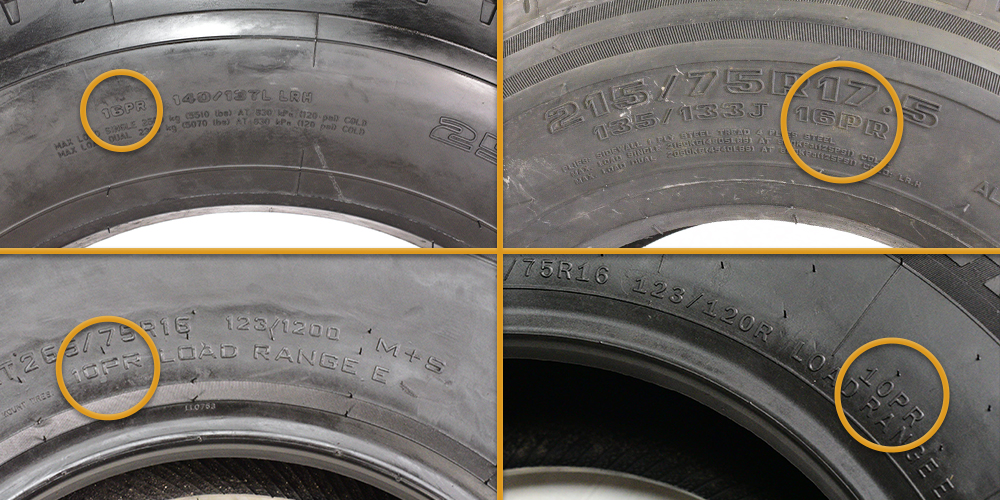Tire Load Range and Ply Rating (In-Depth Guide)
Posted by Agota Szabo on Oct 25th 2022
Tire load range and ply rating go hand in hand. In order for different types of tires to be distinguished and to perform safely, they should not be overloaded.
Each tire rating has a specific load and driving capacity it can handle. Load rating, load range, and ply rating are necessary therefore to determine what a specific tire's durability is.
This might seem confusing, but don't worry! We are here to help you!
Let us walk you through everything you need to know about these tire ratings.
Understanding Tire Load and Ply Ratings
Tires feature their load ranges and ply ratings on their sidewalls. They are markings identifying the maximum load durability of specific tires. It is important to note that tires for different vehicles will feature distinct load ratings.
What is Tire Ply Rating?
First, let's answer "what does ply mean?" and then we can move on.
Plies are added to the tire's sidewall to increase its internal structure and load durability. These tire layers strengthen the load-carrying ability. They can be manufactured from various materials, but the most common are nylon and steel.
The ply rating on tires does not represent the actual number of plies placed in the tire's construction. But, why is that?
Ply Rating History
Back when bias-ply tires were the norm, they had to be reinforced. This was done by using ply layers made from cotton fabric.
To create the bias placement, these plies were used by two. The number of plies added to the structure determined the ply rating of these bias tires. However, that changed when nylon was introduced to tire manufacturing.
Bias plies made from nylon were stronger than cotton ones. Therefore, manufacturers needed to use less of them to achieve the same effect. Additionally, when radial tires and steel belts became the norm, the need for using the exact ply number completely diminished.
Nowadays, the ply rating indicates load durability and works together with the load range rating on tires to show load capacity. In other words, just because the sidewall states 10-ply doesn't mean the tire actually features 10 plies. Yet, they are as strong as a 10-ply tire is when looking at the old, archaic cotton fabric tire ply rating chart.
What is Tire Load Range?
The load range is the maximum load durability of a tire. These tire sidewall ratings are usually used with larger models, such as LT tires.
What load range a tire will have depends on its size and inflation pressure. This is due to the simple fact that larger tires hold more air, which increases their durability.
Additionally, the same tire size can be available with different load ranges. For example, often LT tires are available in both load range C and load range D versions.

Where to Find Ply Rating on the Tire?
The ply rating on tires can be found on their sidewalls. They are near the load range, as they are often interchangeable. This is because the tire's load range correlates to its ply rating as well.
Just be sure you are not looking at the tire load index rating, as that is completely different from these two.
Load Ranges by Tire Type
We have already talked about how tire plies are a thing of the past. Counting the ply of tires is a thing of the past. Instead, tire technology developed a different set of manufacturing aspects in order to categorize tires. These are load ranges.
Depending on the type of tire you need, tire load ratings will be different. Let's see how we can categorize load capacity:
Passenger Tires
When it comes to passenger tires, you have three distinct load ranges. However, apart from the tire load index chart, even passenger tires are categorized into load ranges.
The passenger tire load range chart includes light load, standard load, and extra load tires.

Light Load
Light load tires, or LL models, have a maximum load pressure of 35 psi. This is the weakest passenger tire structure and, therefore, only small tires can be marked as such. By small, we mean tires with 45 or lower aspect ratios. LL tires were created for specific applications.
Standard Load
Standard load tires can feature SL on their sidewall, but often they are not branded with anything. This is because SL load range tires are the most common passenger tires on the market. These tires also have a 35 psi max load pressure.
Extra Load
If you need a strong tire set for your passenger car, extra load tires might be for you. Load range XL tires have a 41 psi max load pressure durability. These tire construction types are able to handle larger loads thanks to their reinforced internal structure. Due to their durability, these tires often last longer than standard load tires.

Light Truck Tires (LT)
After cotton fabric plies were switched with nylon (and other tire developments were implemented), tire brands had to show the load capacity of their products in a different manner.
But, what tire load rating chart do manufacturers use now?
As the number of plies in the tires no longer corresponded with their ply rating, tire brands introduced the load range system. This is where the C and D tire models, along with the rest of the numbers, emerged.

LT-numeric, LT-metric, LT-flotation Tires
When it comes to these tires, we use load ranges to determine their load durability. Each load range letter corresponds to a ply rating (how many plies old bias-ply tires had to provide the same capacity).
This information is crucial for LT vehicles, as it shows exactly how much weight a specific tire will be able to handle. Your vehicle requires heavy-load tires for heavy lifting.
Load range E tires are the most popular. However, manufacturers do not neglect other load ranges either. Basically, what load range you get depends on the needs of your vehicle, but here are a few examples:
- The load Range C weight capacity performs best at 50 psi
- Load Range E is the most popular load range, operating at 80 psi
- Load Range F tire's maximum load pressure is 95 psi
Commercial Vehicle or Van Tires (C)
Tires marked with C by their tire size and manufactured for commercial applications. For this reason, their internal construction and load capacity operate a bit differently as they are smaller, heavy-load tires.
Tire brands optimize these tires based on their load index rating. Whether they are on the vehicle is single or dual applications (2 or 4 tires on a single axle), will also affect the load they can handle per tire. The load index rating is a number located before the speed rating, identifying the max lbs load/tire.
Trailer Tires (ST)
The trailer tire load range chart is basically the same as the LT tire one. This is because special trailer tires also need to handle loads (cargo) without failure. They stamp the load range letter on the sidewall.
These tire load ratings range from load range C (6-ply) to load range J (18-ply). Which trailer tire load range you need will vary based on the trailer you own.

OTR Tires
OTR tires need heavy-duty construction to be able to properly perform. Generally speaking, brands usually manufacture these tires with 10, 12, or 14 ply ratings. However, in reality, they will only feature 2 or 3 actual plies in their structure. Yet, the weight rating on tires will be better the higher ply rating you purchase.
Choosing Tires with the Right Load Index
When searching for aftermarket tires, no matter what type of tire you need, there is one golden rule you need to follow.
That is: do not go lower in load range or load index.
Purchase tires rated the same or higher than your existing tires, even if you keep the same tire size. This will ensure that the new tire set (and new tire load range) will be able to withstand the weight of the vehicle, its passengers, and cargo.
Frequently Asked Questions
How to Tell the Ply of a Tire?
Tire brands mark the ply rating of each tire on the sidewall. For light truck tires, they show this rating as a letter, that represents the number of plies each tire has. However, with modern tire technologies, manufacturers can create stronger plies, so the load ratings now represent their strength only.
What Does the XL Mean on Tires?
Directional tires usually feature a directional, asymmetric tread pattern, which results in a specific vehicle side placement. These tires will have this highlighted on their sidewalls. Directional tread tires are not necessarily directional tires, as you can mount them on both sides.
How Do Tire Treads Increase Friction?
XL means Extra Load and it represents the load and driving durability of SUV and passenger car tire structure. These tires can run at 41 psi maximum tire pressure. Load range XL tires are stronger than SL load range tires, as they feature extra plies to increase durability.
What Is SL Load Range?
SL stands for standard loads. These tires can operate at a maximum load pressure of 35 psi. Standard load tires do not feature reinforced internal structures, manufacturers simply make them for everyday driving.
How Many Ply Is Load Range E?
Brands mark load range E tires to indicate that their durability is equal to 10-ply tires. This means that the plies located in the tire's sidewall are able the handle the same stress as 10 plies can. The load range E weight capacity is 1,520 lbs at 80 psi.
















